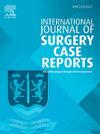Delayed presentation of mature teratoma with umbilical perforation in a 9-years old female without congenital abdominal wall defects: A rare case report of atypical teratoma location
IF 0.6
Q4 SURGERY
引用次数: 0
Abstract
Background
Mature teratomas are benign germ cell tumors that predominantly occur in gonadal regions. Extra-gonadal teratomas, especially in the umbilical region, are rare and often present significant diagnostic challenges. A delayed presentation with umbilical perforation in absence of congenital abdominal wall defects is uncommon.
Case presentation
A 9-year-old female presented with a four-year history of progressively enlarging umbilical mass with occasional discomfort. Examination revealed a firm, pedunculated mass protruding through a perforated umbilicus. A contrasted CT scan, revealed a well-encapsulated heterogeneous mass containing calcifications, with no evidence of deep intra-abdominal involvement. Complete surgical excision of the tumor was performed. Histopathological analysis confirmed a mature teratoma. Recovery was uneventful, and follow-up showed no recurrence.
Discussion
Umbilical teratomas are rare entities, particularly in children without congenital abnormalities. This case illustrates delayed presentation of umbilical perforation and diagnostic challenges in unusual located teratoma, emphasizing the need for high suspicious index when evaluating persistent umbilical masses. Radiology plays a critical role in differentiating these tumors from other conditions like granulomas, infections, or congenital anomalies. Complete surgical excision is the treatment of choice.
Conclusion
This report highlights the rarity and diagnostic complexity of mature teratomas in atypical locations. Early recognition of this rare differential diagnosis in cases of persistent umbilical symptoms is essential to prevent complications such as infection and perforation. Awareness and early intervention are critical to achieving favorable outcomes in such cases. This case contributes to the limited literature on extragonadal teratomas with umbilical perforation and the need for timely diagnosis and management.
一名 9 岁女性的成熟畸胎瘤迟发并伴有脐穿孔,且无先天性腹壁缺损:非典型畸胎瘤位置的罕见病例报告
本文章由计算机程序翻译,如有差异,请以英文原文为准。
求助全文
约1分钟内获得全文
求助全文
来源期刊
CiteScore
1.10
自引率
0.00%
发文量
1116
审稿时长
46 days

 求助内容:
求助内容: 应助结果提醒方式:
应助结果提醒方式:


